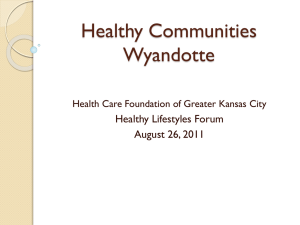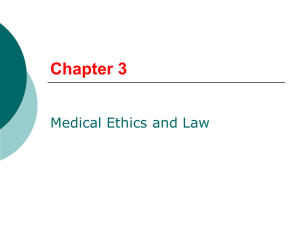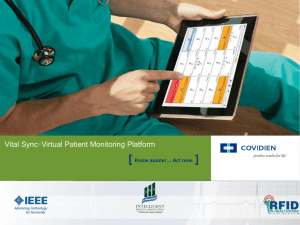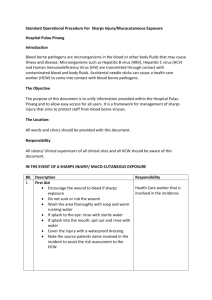Vital Signs in the Ambulatory Setting
advertisement
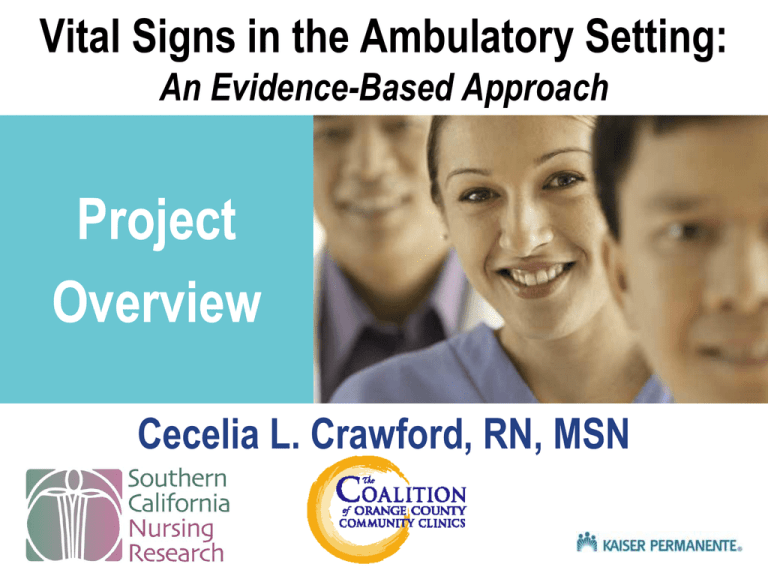
Vital Signs in the Ambulatory Setting: An Evidence-Based Approach Project Overview Presentation title Cecelia SUB TITLE HERE L. Crawford, RN, MSN The Importance of Vital Signs Foundation of clinical assessment Basis for many clinical decisions Accuracy of VS Influences the patient’s clinical course Impacts patient outcomes Therefore, VS should be based on evidence, rather than ritual, routine, & tradition! Frequency of Vital Signs Trends more important than any single measurement Should NOT be used as a method of ensuring Health Care Worker (HCW) visits Standardize methods of VS measurement Frequency of Vital Signs VS parameters do NOT guarantee normal physiological status Have VS become routine & unrelated to patient needs? Is visual observation more important than routine VS? Couple visual patient observation with VS The HCW & Vital Signs Importance of communication What happens to VS data after it is collected is as important as the accuracy of the VS themselves! Educational programs CAN improve HCW vital sign measurement techniques The HCW & Vital Signs HCW has a definite influence on VS Speech Touch Physical presence The HCW & Vital Signs Most influence seen with auscultated blood pressure White coat HTN may contribute 20% towards misdiagnosis of Stage 1 HTN Higher BPs in clinic/work settings Vital Sign Technology Automated machines Electronic/infrared thermometers BP & Pulse Oximetry Convenient May save time & labor not confirmed by current studies Vital Sign Technology Noninvasive Automatic BP is the most favored method Reduction in measurement errors Standardized & calibrated device vs. many HCWs & different techniques Vital Sign Techniques & Methods: An Overview Temperature Pulse Respiratory Rate Blood Pressure Pulse Oximetry (5th VS) Temperature Glass Thermometers Associated with adverse events Rectal/oral trauma Mercury exposure Axillary Temps Great variation with no “norm” found Temperature Oral Temps Position oral thermometers in left or right sublingual pockets NOT influenced by breathing patterns IS influenced by hot & cold fluids Temperature Tympanic Thermometers Can be affected by Extremes in environmental temps Localized heating/cooling measures Ear tug positively affects accuracy Impacted cerumen adversely influences accuracy Temperature Tympanic Temps - Patient Perceptions Parents prefer re: speed, ease, cleanliness, & safety Peds patients reacted more positively Pulse Count for 60 sec Count for 30 sec and multiply X2 Shorter time counts = inaccurate data •Pulse Apical pulse via stethoscope Abnormal pulse Difficult to palpate pulse Pulse rates via automatic devices not discussed in the literature, but often used in the clinical practice setting Respiratory Rate Count for 60 sec Count for 30 sec and multiply X2 Shorter time counts = inaccurate data Respiratory Rate Pediatric patients If panting, use stethoscope to count Agitation can result in inaccurate RR Respiratory Rate RR is NOT a reliable screen for oxygen desaturation states! RN and MD assessment is needed Blood Pressure Use a consistent & standardized method to minimize inaccuracies Machine or auscultation Functional & calibrated machine Korotkoff’s sounds Properly trained HCWs Blood Pressure Procedure (Any Method) Upper arm properly supported at level Proper arm cuff size Patient sitting & at rest for 5 minutes Back supported, legs uncrossed No talking or gestures by patient or HCW Repeat BPs – 2 minutes apart Blood Pressure What if a BP cannot be obtained? What if the cuff doesn’t fit? What if a right-sized cuff isn’t available? HCW should consult with RN or MD for all troubleshooting issues Pulse Oximetry Possible consideration as the 5th VS Use in situations where patient assessment & monitoring is critical VS – It’s All About The Numbers! Terminal Digit Preference HCW may show a preference for certain numbers in Pulse, Respirations, & auscultated BP readings* Zeros, even numbers, odd numbers Research study on BP revealed 99% of auscultated SBP/DBP readings ended in zero, demonstrating lack of adherence to AHA recommendations* HCW should be aware of this possible tendency (*Roubsanthisuk, W., Wongsurin, U., Saravich, S., & Buranakitjaroen, P., 2007) Final Thoughts on VS Tempting to view VS as a routine & static piece of data VS are fluid, dynamic, & ever-changing, just like our patients! Final Thoughts on VS Crucial Vital Sign Decisions Base on the Evidence! Equipment & Technology Technique & Methods HCW Education & Training Frequency Protocols Influences P&Ps & Clinic Setting (and visa versa!) Final Thoughts on VS HCW Education & Training VS Accuracy & Communication of Data Competencies Annual Review of Skills Recommendations - Equipment Automated BP devices (Welch-Allyn) Vital Sign Monitor Tympanic thermometers (Kendall Healthcare) Genius tympanic thermometer Recommendations – Reference Texts American Academy of Ambulatory Care Nurses (2006): Core Curriculum of Ambulatory Care, 2nd Ed., Elsevier Perry & Potter (2006): Clinical Nursing Skills & Techniques, 6th Ed., Mosby Perry & Potter (2006): Skills Performance Checklists: Clinical Nursing Skills and Techniques, 6th Ed., Mosby Recommendations - Procedure Base Policy & Procedures on AAACN Core Curriculum and Perry & Potter Use AAACN Core Curriculum and Perry & Potter as a daily clinical reference Checklists to instruct and validate clinical competence & skills Personal Stories Make it Real! Use real life stories to illustrate how the proper use of vital sign equipment can positively impact the care of your patients… Remember these stories as they happen and pass them along! Vital Signs Conclusions An evidence-based vital sign measurement method provides a foundation for: Patient-HCW Relationships Patient Assessment Patient Treatment Quality Patient Outcomes Shift the paradigm from ritual to science! References American Association of Critical Care Nurses (AACN) (2006). Practice alert: Noninvasive blood pressure monitoring. AACN Newsletter, June 2006, 4-5. Lockwood, C., Conroy-Hiller, T., & Page, T. (2004). Vital signs: Systematic review. Joanna Briggs Institute Reports, 2, 207-230. References Pickering, T.G., Hall, J.E., Appel, L.J., Falkner, B. E., Graves, J., Hill, M. N., Jones, D. W., Kurtz, T., Sheps, S. G., & Roccella, E. J. (2005). Recommendations for blood pressure measurement in humans: A statement for professionals from the subcommittee of professional and public education of the American Heart Association council on high blood pressure research. Hypertension, 45, 142-161. References Roubsanthisuk, W., Wongsurin, U., Saravich, S., & Buranakitjaroen, P. (2007). Blood Pressure Determination By Traditionally Trained Personnel Is Less Reliable And Tends To Underestimate The Severity Of Moderate To Severe Hypertension. Blood Pressure Monitoring, 12 (2), 61-6. References Schell, K., Bradley, E., Bucher, L., Seckler, M., Lyons, D., Wakai, S., Bartell, D., Carson, E., Chichester, M., Foraker, T., & Simpson, K. (2006). Clinical comparison of automatic, noninvasive measurements of blood pressure in the forearm and upper arm. American Journal of Critical Care, 14(3), For more information: Cecelia L. Crawford, RN, MSN Project Manager for Evidence-Based Nursing Practice So. Calif. Nursing Research Program 626-405-5802 Cecelia.L.Crawford@kp.org


